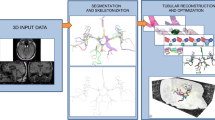Abstract
In this paper, a new solution to the problem of reconstructing the surface of 3D objects over a set of cross-sectional contours is proposed. An algorithm for single branch contours connection, which is based on the closest local polar angle method, is first presented. Then the branching problems (including non-singular branching and singular branching) are completely solved by decomposing them into several single-branching problems. Finally, these methods are applied to the reconstruction of the external surface of a complexly shaped object such as the cellular region of human brain. The results show that the presented methods are practical and satisfactory.
Similar content being viewed by others
Explore related subjects
Discover the latest articles, news and stories from top researchers in related subjects.References
Ekoule A B, Peyrin F C, Odet C L. A triangulation algorithm from arbitrary shaped multiple planar contours.ACM Trans. on Graphics, 1991, 10(2).
Jones M W, Chen M. A new approach to the construction of surface from contour data. InEurgraphics’94, also inComputer Graphics Forum, 1994, 13(3).
Cline H E, Lorensen W E, Ludke S. Two algorithms for the three-dimensional reconstruction of tomography.Med. Phys., 1988, 15(3).
Keppel E. Approximating complex surface by triangulation of contour lines.IBM. J. Res. Dev., 1975, 19: 2–11.
Fuchs H, Kedem. Optimal surface reconstruction from planar contours.CACM, 1977, 20.
Christiansen H N. Conversion of complex contour line definition into ploygonnal elements.Mosaics. Comp. Graph., 1978, 12(3).
Cook P N. Three-dimensional reconstruction from serial-sections for medical application. InProc. of the 14th Hawaii Int’l Conf. on System Science, 1981, 2.
Boissonat J D. Surface reconstruction from planar cross-section. InProc. of IEEE Conf. on Computer Vision and Pattern Recognition, June 1985.
Santz M. Surface definition for branching contour defined objects.Comp. Graph., 1981, 15(2).
Zyda M J M, Allan R J. Surface construction from planar contours.Comp. Graph., 1987, 11(4).
Shinagwa Y, Kunii K. The homotopy model: A generalized model for smooth surface generation from cross-sectional data.Visual Computer, 1991, 7.
Author information
Authors and Affiliations
Corresponding author
Additional information
This paper is supported by The National Natural Science Foundation of China.
Xu Meihe is a Ph.D. candidate in Department of Computer Science, Tsinghua University. He received his B.S. degree in mathematics from Jiangxi Normal University and his M.E. degree in computational mechanics from Chongqing University. His research interests include computer graphics and physically based modeling and visualization.
Tang Zesheng is a Professor in Department of Computer Science, Tsinghua University. He graduated from Tsinghua University in 1953. His research interests include computer graphics, scientific visualization, computational geometry and geometric modeling.
Rights and permissions
About this article
Cite this article
Xu, M., Tang, Z. Surface reconstruction for cross sectional data. J. of Comput. Sci. & Technol. 11, 471–479 (1996). https://doi.org/10.1007/BF02947214
Received:
Revised:
Issue Date:
DOI: https://doi.org/10.1007/BF02947214




